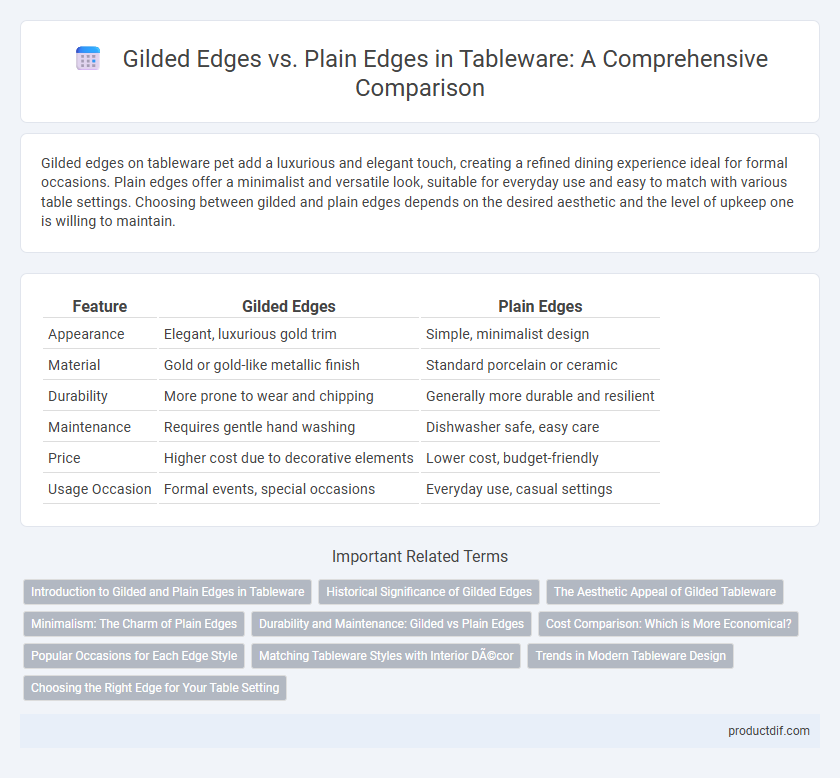Gilded edges on tableware pet add a luxurious and elegant touch, creating a refined dining experience ideal for formal occasions. Plain edges offer a minimalist and versatile look, suitable for everyday use and easy to match with various table settings. Choosing between gilded and plain edges depends on the desired aesthetic and the level of upkeep one is willing to maintain.
Table of Comparison
| Feature | Gilded Edges | Plain Edges |
|---|---|---|
| Appearance | Elegant, luxurious gold trim | Simple, minimalist design |
| Material | Gold or gold-like metallic finish | Standard porcelain or ceramic |
| Durability | More prone to wear and chipping | Generally more durable and resilient |
| Maintenance | Requires gentle hand washing | Dishwasher safe, easy care |
| Price | Higher cost due to decorative elements | Lower cost, budget-friendly |
| Usage Occasion | Formal events, special occasions | Everyday use, casual settings |
Introduction to Gilded and Plain Edges in Tableware
Gilded edges in tableware feature a thin layer of metal, often gold or silver, applied to the rim, adding elegance and a luxurious finish to plates, bowls, and cups. Plain edges offer a minimalist and versatile design that emphasizes simplicity and functionality, making them suitable for everyday use and casual settings. The choice between gilded and plain edges significantly influences the tableware's aesthetic, atmosphere, and occasion appropriateness.
Historical Significance of Gilded Edges
Gilded edges on tableware trace back to ancient civilizations like Egypt and Rome, symbolizing wealth and social status through the use of gold leaf or gold paint. During the Victorian era, gilded edges became especially popular among European aristocracy, reflecting intricate craftsmanship and luxury in porcelain and china. This historical significance of gilded edges underscores their role not merely as decoration but as markers of cultural prestige and artisanal skill.
The Aesthetic Appeal of Gilded Tableware
Gilded edges on tableware create a luxurious and elegant aesthetic that elevates the dining experience with their shimmering gold accents. These intricate gold trims highlight the craftsmanship and add a sophisticated contrast to plain porcelain or ceramic surfaces. Unlike plain edges, gilded tableware is often chosen for formal settings and special occasions due to its rich visual appeal and timeless charm.
Minimalism: The Charm of Plain Edges
Plain edges in tableware epitomize minimalist design, emphasizing clean lines and understated elegance that suit contemporary dining settings. This simplicity enhances versatility, allowing seamless pairing with various table linens and centerpieces while drawing attention to the food itself. In contrast to gilded edges, plain edges avoid visual clutter, aligning with modern preferences for functional beauty and subtle sophistication.
Durability and Maintenance: Gilded vs Plain Edges
Gilded edges on tableware often feature delicate gold or metallic trims that require gentle handling and specialized cleaning to prevent fading or chipping, impacting their long-term durability. Plain-edged tableware, typically made from unadorned ceramic or porcelain, offers enhanced robustness and easier maintenance due to its resistance to wear and compatibility with dishwasher cleaning. Choosing between gilded and plain edges depends on balancing aesthetic appeal with practical longevity and upkeep.
Cost Comparison: Which is More Economical?
Gilded edges increase the cost of tableware due to the use of precious metals like gold or platinum, along with the additional labor for applying and firing the gilding. Plain-edged tableware is significantly more economical, as it requires fewer materials and simpler manufacturing processes. For budget-conscious consumers or large-scale catering, plain edges offer a practical balance of durability and affordability.
Popular Occasions for Each Edge Style
Gilded edges on tableware are popular for formal occasions such as weddings, anniversaries, and upscale dinner parties due to their luxurious and elegant appearance. Plain edges are favored for everyday use, casual gatherings, and outdoor events, offering a minimalist and versatile look that suits various dining settings. The choice between gilded and plain edges often reflects the event's tone and desired ambiance.
Matching Tableware Styles with Interior Décor
Gilded edges on tableware add a touch of luxury and elegance, complementing traditional or vintage interior decor with rich textures and warm color palettes. Plain edges provide a minimalist and versatile aesthetic, blending seamlessly with modern, Scandinavian, or industrial design styles characterized by clean lines and neutral tones. Matching tableware styles to interior decor enhances the overall dining ambiance and creates a cohesive visual experience.
Trends in Modern Tableware Design
Gilded edges on modern tableware evoke luxury and elegance, often associated with formal dining and special occasions, reflecting a resurgence in vintage-inspired design trends. Plain edges emphasize minimalism and functionality, aligning with contemporary preferences for clean lines and sustainability in everyday use. Current trends show a balanced fusion, where designers integrate subtle gilding with simple forms to appeal to eclectic tastes and versatile table settings.
Choosing the Right Edge for Your Table Setting
Gilded edges elevate tableware with a luxurious gold or metallic trim, perfect for formal occasions and adding a touch of elegance to your dining experience. Plain edges offer a minimalist, versatile look that complements both casual and contemporary settings while being easier to maintain and less prone to wear. Selecting the right edge depends on the occasion, aesthetic preferences, and practical considerations such as durability and cleaning.
Gilded Edges vs Plain Edges Infographic

 productdif.com
productdif.com